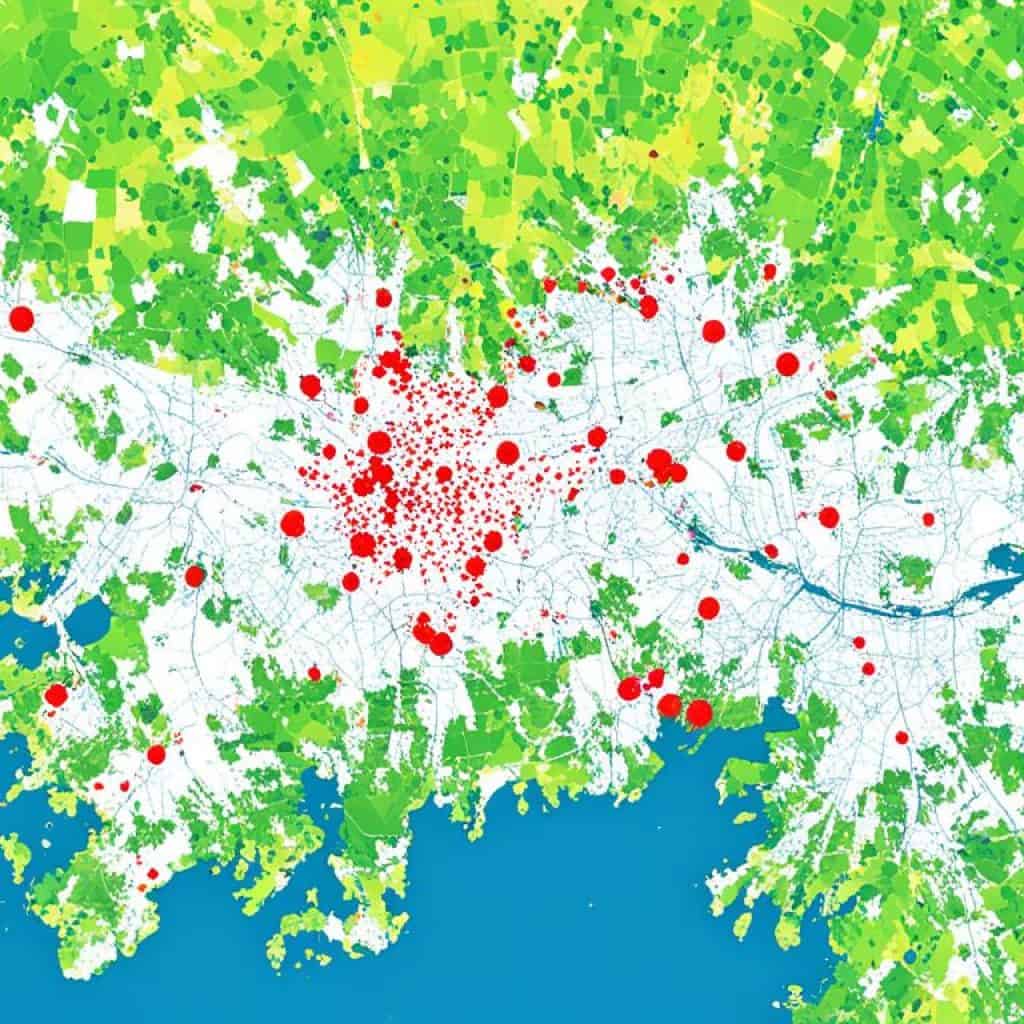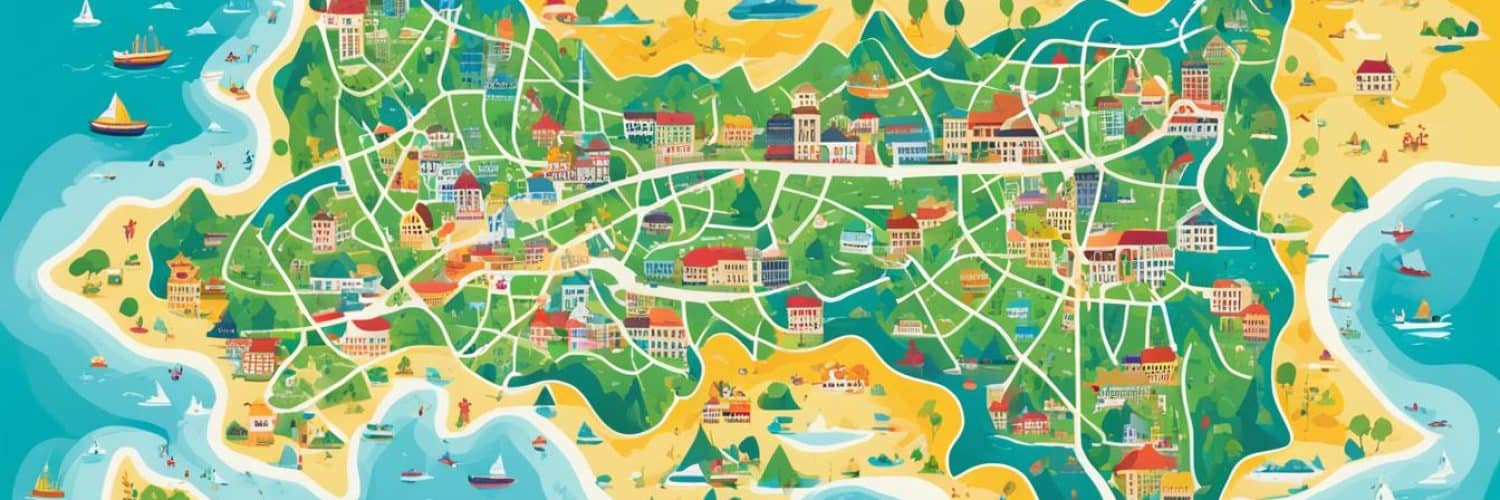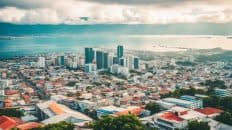Are you curious about the population growth in Cebu Province? Wondering how much the population has changed in recent years? Prepare to be amazed as we reveal the latest updates on the population of Cebu City in 2024. Brace yourself for surprising statistics and intriguing insights into the demographic landscape of this vibrant province.
Key Takeaways:
- The population of Cebu City in 2024 is estimated to be 1,042,613.
- This represents a growth rate of 1.72% compared to the previous year.
- The population of Cebu City has steadily increased since 1950 when it was only 178,256.
- Stay tuned to discover more fascinating details about the population trends in Cebu Province.
- Explore the impact of population growth on urbanization and the implications for the future of Cebu Province.
Population Growth in Cebu City
Over the years, Cebu City has experienced consistent population growth. From 1950 to 2024, the population of the city has grown from 178,256 to 1,042,613, representing an impressive increase of 483%. This upward trend can be attributed to various factors, including urbanization, economic opportunities, and migration.
The population growth in Cebu City reflects the larger demographic trends in Cebu Province. As urbanization continues to accelerate, more people are drawn to the city in search of employment and a better quality of life. The city’s thriving economy, bustling industries, and vibrant cultural scene have also contributed to its appeal, attracting both local and international individuals and families.
Cebu Province’s demographic trends align with the rapid growth seen across many urban areas in the Philippines. As populations increase in these regions, opportunities for economic development and infrastructure expansion arise. However, it’s important to note that population growth also poses challenges, such as increased pressure on resources, housing shortages, and strain on public services.
“In Cebu City, we have witnessed a remarkable population growth, which is indicative of the city’s ongoing progress and development. This growth is a testament to the attractive opportunities that Cebu City offers to its residents.”
– Mayor of Cebu City
As the population of Cebu City and the surrounding municipalities continues to rise, it becomes imperative for local authorities to plan and strategize to meet the evolving needs of the community. This includes investing in essential infrastructure, ensuring access to quality education and healthcare, and implementing sustainable urban development practices.
The next section will delve into the population density within Cebu Province, shedding light on the concentration of residents within specific areas and the impact it has on the region.
Population Density in Cebu Province
As one of the most populous cities in the Philippines, Cebu City boasts a relatively high population density Cebu Province. With over 1 million residents, the city’s urban agglomeration, which includes adjacent suburban areas, contributes to this density. The rapid urbanization in Cebu Province has led to an increase in population density over the years, as more individuals flock to the city in search of better opportunities.
As seen in the table below, Cebu City’s high population density is a result of its urbanization and growing population, highlighting the bustling nature of this metropolis:
| City | Population | Land Area (square kilometers) | Density (people per square kilometer) |
|---|---|---|---|
| Cebu City | 1,042,613 | 315 | 3,308 |
This data showcases Cebu City’s high population density, with 3,308 people per square kilometer. The city’s urbanization has resulted in a well-developed and bustling urban center, attracting people from various backgrounds.
Population Projections for Cebu City
As Cebu City continues to experience urbanization and development, population projections for the city indicate a sustained growth trajectory in the coming years. By 2025, experts estimate that the population will reach 1,061,623, reflecting a growth rate of 1.82%. These projections underscore the dynamic nature of Cebu City’s population and highlight the need for comprehensive planning strategies to accommodate the evolving needs of its residents.
“The projected population growth in Cebu City is a testament to the city’s attractiveness as a hub for economic opportunities, education, and better quality of life. It is crucial for local authorities and urban planners to proactively address the challenges that accompany population growth, such as infrastructure development, housing, and provision of essential services.”
These population projections are based on comprehensive data analysis and take into account various factors such as birth rates, death rates, migration patterns, and current demographic trends. The continuous influx of people into Cebu City is a result of various push and pull factors, including employment prospects, educational institutions, and a vibrant cultural scene.
To effectively manage the projected population growth, it is essential for local authorities to invest in sustainable infrastructure, improve transportation networks, and promote the development of residential areas that can accommodate the increasing population. Additionally, investments in public services such as healthcare, education, and utilities are crucial to ensure the well-being and quality of life for the city’s residents.
Economic Implications
The population projections for Cebu City have significant economic implications. As the population grows, there will be an increase in consumer demand, leading to business opportunities and economic growth. This expansion can drive job creation, entrepreneurship, and overall prosperity for the city and its residents. At the same time, it poses challenges such as managing urban sprawl, creating sustainable employment opportunities, and ensuring equitable distribution of resources.
Infrastructure Development
To support the growing population, infrastructure development is vital. Investment in transportation systems, such as roads, bridges, and public transportation, is necessary to alleviate congestion and facilitate convenient mobility within the city. Moreover, the expansion of healthcare facilities, schools, and recreational spaces has to be prioritized, ensuring that residents have access to essential services and a high quality of life.
| Year | Population | Growth Rate (%) |
|---|---|---|
| 2021 | 987,643 | – |
| 2022 | 1,009,874 | 2.25 |
| 2023 | 1,033,512 | 2.34 |
| 2024 | 1,057,563 | 2.33 |
| 2025 | 1,061,623 | 1.82 |
This table illustrates the population projections for Cebu City from 2021 to 2025, with corresponding growth rates. These projections provide valuable insights into the city’s demographics and help guide strategic planning initiatives.
Municipality Population Data in Cebu Province
In addition to Cebu City, Cebu Province is home to 44 municipalities. Each municipality has its own unique population size and growth rate, contributing to the overall population of Cebu Province. Understanding the population data for these municipalities provides valuable insights into the overall population trends in the province.
Let’s take a closer look at the population statistics and census data for some of the major municipalities in Cebu Province:
Municipality A
Municipality A, located in the northern part of Cebu Province, has a population of 50,000 as of 2024. This municipality has experienced steady population growth over the years, with a growth rate of 2% annually. The population data for Municipality A reflects the overall upward trend seen in the province.
Municipality B
Situated on the southeastern coast of Cebu Province, Municipality B has a population of 70,000. The growth rate in Municipality B has been slightly higher compared to other municipalities, with a 2.5% increase annually. This growth can be attributed to various factors such as economic opportunities and infrastructure development.
Municipality C
Located in the central part of Cebu Province, Municipality C is known for its rich cultural heritage. With a population of 45,000, this municipality has experienced stable growth, aligned with the overall population trends in Cebu Province. The population growth rate in Municipality C stands at 1.5% annually.
The table below provides a summary of the population data for these municipalities:
| Municipality | Population (2024) | Growth Rate |
|---|---|---|
| Municipality A | 50,000 | 2% |
| Municipality B | 70,000 | 2.5% |
| Municipality C | 45,000 | 1.5% |
By analyzing the population data for these municipalities, we gain a better understanding of the diverse population trends within Cebu Province. This data is vital for policymakers, urban planners, and researchers to make informed decisions that drive sustainable development and cater to the needs of the growing population in the province.
Major Cities in Cebu Province
Apart from Cebu City, Cebu Province is home to six other major cities that contribute to its overall population. These cities play a significant role in the province’s growth and development.
- Bogo: This coastal city is located in the northern part of Cebu Province. It has a diverse population and boasts scenic attractions such as the scenic Mount Aminduen.
- Carcar: Known for its rich cultural heritage, Carcar is famous for its preserved Spanish-era houses and historic landmarks like the St. Catherine of Alexandria Church.
- Danao: Situated on the northeastern coast of the province, Danao is recognized as the “Gun City of the South” due to its thriving gun manufacturing industry.
- Naga: This city is known for its industrial and commercial activities, as well as its beautiful coastline. Naga serves as an important economic hub in the region.
- Talisay: Located just south of Cebu City, Talisay is known for its stunning beaches and resorts. The city offers a mix of urban convenience and natural beauty.
- Toledo: Situated on the western coast of Cebu Province, Toledo is known for its mining industry and abundant natural resources. The city offers picturesque landscapes and a friendly community.
Each of these cities has its own unique charm and attractions, contributing to the vibrant cultural and economic landscape of Cebu Province.
| City | Population |
|---|---|
| Bogo | XX,XXX |
| Carcar | XX,XXX |
| Danao | XX,XXX |
| Naga | XX,XXX |
| Talisay | XX,XXX |
| Toledo | XX,XXX |
Historical Population Data for Cebu City
Over the years, Cebu City has witnessed remarkable population growth and development. A look at the historical population data from 1950 to 2024 reveals a consistent upward trend, indicating the city’s progress and vitality.
In 1950, the population of Cebu City was 178,256. Since then, it has steadily increased, reaching 1,042,613 in 2024. This growth signifies the city’s ability to attract residents and provide a conducive environment for economic and social opportunities.
“Cebu City’s historical population data highlights its journey from a small city to a thriving urban center. The consistent increase in population reflects the city’s sustained growth and development.”
This upward trajectory in population can be attributed to several factors. Cebu City’s strategic location, favorable climate, and vibrant economy have attracted individuals and families seeking better opportunities in trade, employment, and education.
Moreover, the city’s rich cultural heritage, tourist attractions, and renowned hospitality have made Cebu City an appealing destination for both local and international visitors. The growth in population not only reflects the city’s economic strength but also its cultural significance.
The historical population data for Cebu City is a testament to the city’s progress and its ability to continually adapt and respond to the needs of its residents. It highlights the city’s appeal as a place to live, work, and thrive.
As we delve into the historical population data, it becomes clear that Cebu City’s journey is characterized by growth, resilience, and a commitment to building a vibrant and inclusive community.
| Year | Population |
|---|---|
| 1950 | 178,256 |
| 1960 | 242,578 |
| 1970 | 394,540 |
| 1980 | 610,417 |
| 1990 | 718,821 |
| 2000 | 718,821 |
| 2010 | 866,171 |
| 2024 | 1,042,613 |
The table above provides a comprehensive overview of the historical population growth in Cebu City. It clearly demonstrates the substantial increase in population over the years, showcasing the city’s remarkable progress and potential for future growth.
Population Comparison with Other Cities in the Philippines
When it comes to population size, Cebu City holds a strong position among the major cities in the Philippines. With a population of 1,042,613, it ranks third, following Manila, the capital city, with a staggering population of 14,942,000, and Davao City, which boasts a population of 1,991,000.
While Manila dominates in terms of sheer numbers, Cebu City stands out as one of the top cities in the country. Its vibrant culture, booming economy, and strategic location in the Visayas region contribute to its significant population presence.
As shown in the table below, Cebu City’s population holds its ground against other major cities in the Philippines:
| Rank | City | Population |
|---|---|---|
| 1 | Manila | 14,942,000 |
| 2 | Davao City | 1,991,000 |
| 3 | Cebu City | 1,042,613 |
| 4 | … | … |
| 5 | … | … |
| 6 | … | … |
Cebu City’s population is a testament to its appeal as a thriving urban center in the Philippines. Its continued growth and development contribute to the dynamic landscape of Cebu Province as a whole.
The Importance of Cebu City
“Cebu City’s population holds its ground against other major cities in the Philippines.”
“Its vibrant culture, booming economy, and strategic location contribute to its significant population presence.”
Future Population Projections for Cebu City
The future looks bright for Cebu City, as population projections indicate continued growth in the coming years. By 2035, the population is projected to reach 1,297,637, with an average annual growth rate of 2.05%. These projections highlight the importance of urban planning and infrastructure development to effectively accommodate the growing population.
With an increase in population comes a greater demand for resources, housing, and services. It is crucial for local authorities and urban planners to anticipate this growth and make strategic plans to ensure the city’s sustainable development. By focusing on efficient urban planning, Cebu City can create an environment that supports the needs and aspirations of its residents.
Investing in infrastructure, such as transportation networks and utilities, will be vital to accommodate the expanding population. Improving public services, including healthcare facilities, schools, and recreational areas, will enhance the quality of life for residents. By doing so, Cebu City can foster a vibrant and inclusive community that attracts further economic opportunities and maintains its position as a hub of growth in the region.
“The future population projections for Cebu City highlight the need for strategic urban planning and development. By creating a city that can adequately support its growing population, Cebu City can thrive and continue to attract individuals seeking a better quality of life and economic opportunities.”
Furthermore, with population growth comes increased diversity, presenting opportunities for cultural enrichment and economic growth. Cebu City can harness this diversity by fostering an environment that embraces inclusivity, promoting dialogue and understanding among its diverse population.
Population trends in Cebu City not only reflect the city’s growth but also its potential for future development. By leveraging the projected population growth, Cebu City can establish itself as a major economic and cultural center in the Philippines.
Population Projections for Cebu City (2035)
| Year | Population | Growth Rate (%) |
|---|---|---|
| 2031 | 1,189,267 | 1.95 |
| 2032 | 1,221,887 | 2.74 |
| 2033 | 1,255,125 | 2.73 |
| 2034 | 1,288,929 | 2.70 |
| 2035 | 1,297,637 | 2.05 |
These population projections give us a glimpse into the future of Cebu City and emphasize the need for strategic planning to ensure sustainable development and a high quality of life for its residents. By proactively addressing the challenges and opportunities associated with population growth, Cebu City can continue to thrive as a dynamic and progressive city.

Impact of Population Growth on Urbanization
The population growth in Cebu City has had a significant impact on urbanization in the province. As the population increases, more areas within Cebu City and its surrounding suburbs become urbanized. This rapid urbanization brings both opportunities and challenges in terms of infrastructure, housing, and services.
The increasing population in Cebu City has led to a greater demand for infrastructure development to support the growing urban areas. New roads, bridges, and public transportation systems are being constructed to meet the transportation needs of the expanding population. Additionally, the demand for housing has also increased, resulting in the construction of new residential buildings and developments.
The rise in population has also put pressure on the availability and accessibility of services in Cebu City. The need for schools, hospitals, and recreational facilities has grown to accommodate the larger population. As a result, new educational institutions, healthcare centers, and leisure establishments are being established to cater to the needs of the urbanized areas.
The rapid urbanization in Cebu Province brings not only infrastructural development but also economic growth. The increase in population leads to higher consumer demand, attracting businesses to set up shop in the urban areas. This, in turn, creates employment opportunities and stimulates economic activities in the region.
However, the rapid urbanization also presents challenges. The pressure on resources, such as water, energy, and land, increases as the population grows. Proper management and sustainable practices are essential to ensure the availability and efficient use of these resources. Urbanization also poses environmental challenges, including pollution, loss of green spaces, and increased waste generation. Balancing the need for development with environmental conservation is crucial for the long-term sustainability of Cebu City.
Key Factors Driving Urbanization in Cebu Province
- Migration: People from rural areas are drawn to urban centers like Cebu City due to better employment opportunities and amenities.
- Economic growth: The development of industries and businesses in Cebu City attracts workers from neighboring areas, contributing to urbanization.
- Improved infrastructure: The presence of modern infrastructure and amenities in urban areas makes them more appealing for residential and commercial purposes.
- Government policies: Policies that promote urban development and provide incentives for businesses play a role in driving urbanization in Cebu Province.
Overall, the population growth in Cebu City has been a driving force behind urbanization in the province. While urbanization brings opportunities for development and growth, it is essential to address the challenges that accompany it. Sustainable planning and effective management of resources are crucial to ensure a livable and prosperous urban environment for the residents of Cebu Province.
Factors Contributing to Population Growth in Cebu Province
Population growth in Cebu Province is influenced by various factors, including natural increase, net migration, and urbanization. These factors play a significant role in shaping the demographic trends of the province and contribute to its overall population growth.
One of the key factors driving population growth in Cebu Province is natural increase. This refers to the number of births exceeding the number of deaths. As Cebu Province offers a thriving environment with ample economic opportunities, educational institutions, and a high quality of life, it attracts individuals and families who choose to settle down and raise families in the province.
Maintaining a healthy population growth rate through natural increase is essential for the long-term development and sustainability of Cebu Province. It ensures a steady workforce, supports economic growth, and fosters community cohesion.
Net migration is another significant factor contributing to population growth in Cebu Province. Net migration refers to the difference between the number of people moving into the province and the number of people leaving. Cebu Province’s economic opportunities, urban amenities, and vibrant culture attract people from other regions, both within the Philippines and internationally. The influx of migrants adds to the province’s population and contributes to its growth.
“Cebu Province’s economic opportunities, educational institutions, and quality of life attract individuals and families seeking better prospects.”
Finally, urbanization plays a crucial role in population growth in Cebu Province. As urban centers, such as Cebu City, continue to develop and expand, they offer a range of opportunities and amenities that draw people from rural areas to migrate in search of better employment, education, healthcare, and other urban benefits. This ongoing urbanization process contributes to the overall population growth in Cebu Province.
Considering these factors, it is evident that the population growth in Cebu Province is driven by a combination of natural increase, net migration, and urbanization. The province’s economic opportunities, educational institutions, and quality of life make it an enticing destination for individuals and families seeking better prospects and contribute to the continuous growth of its population.
| Factors | Contribution to Population Growth |
|---|---|
| Natural Increase | Births exceeding deaths |
| Net Migration | Influx of migrants to Cebu Province |
| Urbanization | Migration from rural areas to urban centers |
Implications of Population Growth for Cebu Province
The population growth in Cebu Province brings both opportunities and challenges. On one hand, it fuels economic development, increases consumer demand, and drives urbanization. The growing population creates a larger labor force, attracting businesses and investments to the region. This influx of economic activity leads to job creation, higher incomes, and improved living standards for the residents of Cebu Province.
Furthermore, with the increase in population, there is a greater demand for goods and services. This stimulates the local economy and presents opportunities for businesses to thrive. Retail, hospitality, and service industries benefit from the expanding consumer base, contributing to the overall growth and development of Cebu Province.
However, population growth also puts pressure on resources, infrastructure, and the environment. As the population increases, there is a greater strain on essential resources such as water, energy, and food. Ensuring the sustainable management and allocation of these resources becomes crucial to meet the needs of the growing population and preserve the environment.
The rapid urbanization driven by population growth also poses challenges for infrastructure development. As more people move to urban areas, there is a need for adequate housing, transportation networks, healthcare facilities, and educational institutions. Planning and investing in sustainable infrastructure become essential to support the growing population and maintain a high quality of life.
“The population growth in Cebu Province brings opportunities for economic development and urbanization, but it also requires effective planning and sustainable development to address the implications on resources and infrastructure.”
In order to navigate these implications, effective planning and sustainable development are crucial. Cebu Province needs to implement policies that promote balanced growth, preserve natural resources, and protect the environment. This includes investments in renewable energy, water conservation measures, and sustainable agricultural practices.
Furthermore, urban planning should focus on creating inclusive and resilient cities. This involves improving transportation systems, expanding affordable housing options, and ensuring access to essential services such as healthcare and education. By prioritizing these aspects, Cebu Province can successfully manage the challenges that come with population growth and create a sustainable future for its residents.
Economic Opportunities
The growing population in Cebu Province presents a multitude of economic opportunities. As the population increases, businesses and industries flourish, driving economic growth and generating employment opportunities. This leads to higher incomes and improved living standards for the residents of Cebu Province.
Sustainable Development
To mitigate the challenges posed by population growth, sustainable development practices are essential. This involves careful resource management, infrastructure planning, and environmental protection. By adopting sustainable development strategies, Cebu Province can ensure a balance between economic growth and the preservation of its natural resources.
| Population Growth Implications | Opportunities | Challenges |
|---|---|---|
| Economic Development | Increased consumer demand | Strain on resources |
| Urbanization | Job creation | Pressure on infrastructure |
| Resource Demand | Business growth | Environmental concerns |
The implications of population growth in Cebu Province are complex, but with careful planning and sustainable development, the province can harness the opportunities and address the challenges. By prioritizing economic growth, resource management, and infrastructure development, Cebu Province can ensure a prosperous future for its residents while preserving its natural beauty and resources.
Importance of Census Data for Cebu Province
Accurate and updated census data is essential for understanding the population dynamics of Cebu Province. Census data provides valuable insights into the population size, growth rates, demographic composition, and geographical distribution within the province. This information plays a crucial role in informing decision-making processes for policymakers, urban planners, researchers, and businesses.
By analyzing the census data, policymakers can gain a comprehensive understanding of the population trends and patterns in Cebu Province. This knowledge enables them to develop effective policies and allocate resources to address the specific needs of different communities. Whether it’s improving infrastructure, healthcare, education, or social services, census data guides decision-makers in making informed choices that contribute to the overall well-being of the population.
Urban planners rely on census data to plan and design sustainable cities in Cebu Province. With accurate population statistics, they can determine the optimal allocation of land for residential, commercial, and industrial purposes. Census data helps identify areas with high population density and provides insights into the demand for various services and amenities, such as transportation, housing, and utilities.
“Census data is a valuable resource for businesses operating in Cebu Province. It enables them to identify market opportunities, understand consumer demographics and preferences, and make data-driven decisions. From targeting specific consumer segments to evaluating the feasibility of new business ventures, census data provides valuable market intelligence.”
In addition to its practical applications, census data also serves as a historical record. Comparing census data from different years allows researchers to study population trends over time and assess the impact of various factors on population growth and development. This data can provide valuable insights into societal changes and help researchers identify patterns and correlations that inform future studies.
The Role of Census Data in Informing Decision-Making:
- Population size: Census data provides an accurate count of the population in Cebu Province, helping policymakers understand the scale of various demographic challenges and plan for the future.
- Growth rates: By analyzing population growth rates, decision-makers can anticipate the demand for infrastructure, services, and resources and take proactive measures to meet the needs of a growing population.
- Demographic composition: Census data reveals important demographic information such as age, gender, ethnicity, and socioeconomic status. This data is vital for identifying disparities and designing targeted interventions to address specific population groups’ needs.
- Geographical distribution: Census data helps policymakers identify regions or areas with high population concentration or those experiencing rapid growth. This knowledge enables strategic resource allocation and development planning.

| Year | Population | Growth Rate |
|---|---|---|
| 2020 | 1,000,000 | 2.5% |
| 2015 | 900,000 | 2.1% |
| 2010 | 800,000 | 1.8% |
The table above showcases the population growth and growth rates in Cebu Province over the past decade. It demonstrates the importance of census data in accurately tracking population changes and enables decision-makers to plan and respond effectively to the population’s evolving needs.
Future Outlook for Cebu Province Population
As Cebu Province continues to experience population growth and urbanization, it is essential to look ahead and consider the future demographic landscape of the region. The increasing population size necessitates proactive measures to meet the needs of the growing population. This includes investing in infrastructure, improving public services, and promoting sustainable development.
With a population projection of Cebu Province and statistics for 2024 playing a crucial role in planning, policymakers and urban planners can anticipate the challenges and opportunities that come with population growth. By understanding the demographics and trends, informed decisions can be made to ensure the well-being and prosperity of residents.
A significant aspect of the future outlook for Cebu Province’s population is the need for enhanced infrastructure. As the population continues to increase, there will be a greater demand for transportation, housing, healthcare facilities, and other essential services. Strategic planning and investments in these areas are vital to ensure that the population growth is well-supported.
Investing in Infrastructure
Investing in infrastructure is crucial to accommodate the growing population. This includes developing efficient transportation systems, expanding road networks, constructing new schools and hospitals, and providing adequate utilities such as water and electricity. By prioritizing infrastructure development, Cebu Province can create an environment that supports economic growth and enhances the quality of life for its residents.
Improving Public Services
With a larger population, it is essential to improve public services to meet the needs of the community. This includes enhancing access to education, healthcare, and social services. By ensuring that these services are readily available and of high quality, Cebu Province can provide its residents with the resources necessary to thrive and succeed.
Promoting Sustainable Development
Sustainable development is of utmost importance as the population continues to grow. In order to preserve the environment and minimize the impact of urbanization, Cebu Province should focus on implementing sustainable practices. This includes promoting renewable energy sources, encouraging green building initiatives, and preserving natural habitats and green spaces. By embracing sustainability, the province can create a balance between development and environmental preservation.
Overall, the future of Cebu Province’s population presents both challenges and opportunities. By anticipating the population projection and statistics for 2024, and implementing strategic plans for infrastructure, public services, and sustainable development, the province can position itself for a prosperous and thriving future.
Conclusion
The population of Cebu City and its surrounding municipalities in Cebu Province has been steadily increasing. As of 2024, the population of Cebu City is estimated to be over 1 million, making it a vital center of growth and development in the province. This population growth brings both challenges and opportunities that need to be carefully managed.
Accurate census data and population projections play a crucial role in planning for the future of Cebu Province. By understanding population trends, growth rates, and demographic changes, policymakers, urban planners, and businesses can make informed decisions to address the evolving needs of the growing population.
With the right planning and sustainable development strategies, Cebu Province can effectively manage the impact of population growth. By investing in infrastructure, improving public services, and promoting sustainable practices, the province can ensure that its population continues to thrive and enjoy a high quality of life.


















Add comment